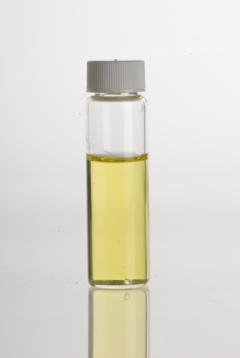Jojoba oil

Jojoba oil (pronounced "ho-HO-bah") is the liquid wax produced in the seed of the jojoba (Simmondsia chinensis) plant, a shrub native to southern Arizona, southern California and northwestern Mexico. The oil makes up approximately 50% of the jojoba seed by weight.[1]
Composition
Jojoba oil is a mixture of wax esters, 36 to 46 carbon atoms in length. Each molecule consists of a fatty acid and a fatty alcohol joined by an ester bond. 98% of the fatty acid molecules are unsaturated at the 9th carbon-carbon bond (omega-9) [2] The approximate percentages of fatty acids in jojoba oil are as follows:
| Fatty acid | Min | Max |
|---|---|---|
| Eicosenoic | 66% | 71% |
| Docosenoic | 14% | 20% |
| Oleic | 10% | 13% |
Appearance

Unrefined jojoba oil appears as a clear golden liquid at room temperature with a slightly fatty odor. Refined jojoba oil is colorless and odorless. The melting point of jojoba oil is approximately 10°C[3] and the iodine value is approximately 80.[4] Jojoba oil is relatively shelf-stable when compared with other vegetable oils. It has an Oxidative Stability Index of approximately 60,[5] which means that it is more shelf-stable than oils of safflower oil, canola oil, almond oil or squalene but less than castor oil, macadamia oil and coconut oil.
Uses
Unlike common vegetable oils, jojoba oil is chemically very similar to human sebum[citation needed]. Most jojoba oil is consumed as an ingredient in cosmetics and personal care products, especially skin care and hair care. Jojoba derivatives, including jojoba esters, isopropyl jojobate and jojoba alcohol, are particularly widely used in this context.
Jojoba oil can be used to remove kohl.
Jojoba oil is popular with stretched lobes. It aids in the healing process.
Jojoba oil is also used as a replacement for whale oil and its derivatives, such as cetyl alcohol. The ban on importing whale oil to the US in 1971 led to the discovery that it is "in many regards superior to sperm oil for applications in the cosmetics and other industries."[1]
Jojoba oil is a fungicide, and can be used for controlling mildew.[6]
Jojoba oil is edible, but acaloric and non-digestible, meaning the oil will pass through the intestines unchanged and can cause an unpleasant result called steatorrhea.
Jojoba oil is an exceptional moisturizer.[7]
Jojoba biodiesel has been explored as a cheap, sustainable fuel that can serve as a substitute for petroleum diesel.[8]
See also
References
- ^ a b D.J. Undersander, E.A. Oelke, A.R. Kaminski, J.D. Doll, D.H. Putnam, S.M. Combs, and C.V. Hanson (1990). "Jojoba". Alternative Field Crops Manual.
{{cite journal}}: CS1 maint: multiple names: authors list (link) - ^ Spencer GF, Plattner RD, Miwa T. 1997. Jojoba oil analysis by high pressure liquid chromatography and gas chromatography/mass spectrometry Journal of the American Oil Chemists' Society 54(5).
- ^ "AOCS Method Cc 18-80". Retrieved 2006-10-13.
- ^ "AOCS Method Cd 1-25". Retrieved 2006-10-13.
- ^ "AOCS Method Cd 12b-92". Retrieved 2006-10-13.
- ^ US 6174920 Method of controlling powdery mildew infections of plants using jojoba wax
- ^ A. R. Place (1992). "Comparative aspects of lipid digestion and absorption: physiological correlates of wax ester digestion" (abstract). AJP - Regulatory, Integrative and Comparative Physiology. 263 (3): 464–R471. PMID 1415629. Retrieved 2008-03-17.
{{cite journal}}: Unknown parameter|day=ignored (help); Unknown parameter|month=ignored (help) - ^ "Jojoba oil could fuel cars and trucks". New Scientist. March 6 2003. Retrieved 2006-10-13.
{{cite web}}: Check date values in:|date=(help)
External links
- "Glossary". International Jojoba Export Council.
- Naqvi, H.H. and I.P. Ting (1990). "Jojoba: A unique liquid wax producer from the American desert". Advances in new crops. Timber Press, Portland, OR. pp. 247-251.
{{cite conference}}: Unknown parameter|booktitle=ignored (|book-title=suggested) (help) - Description and chemical structure of jojoba oil
